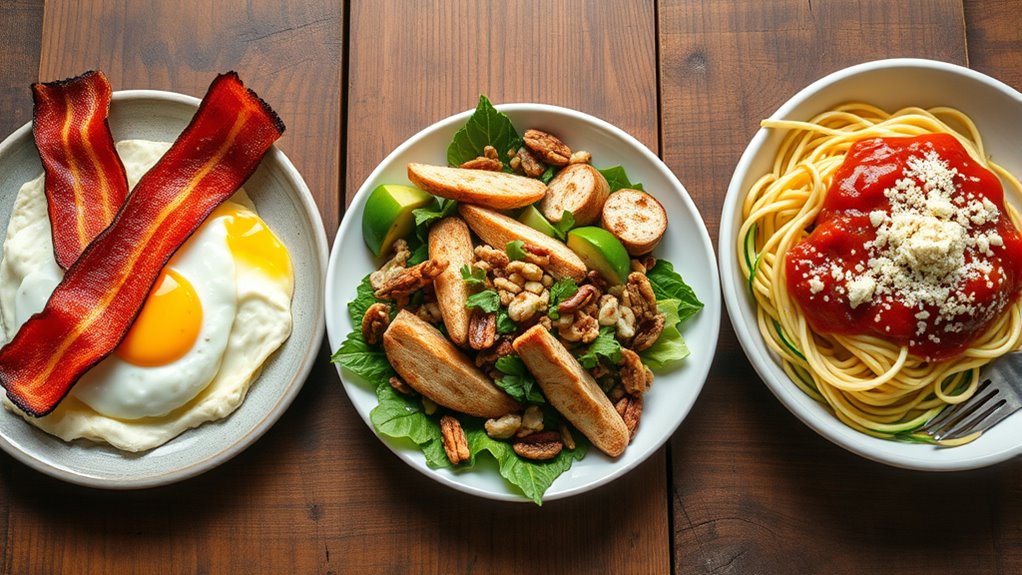When comparing keto to paleo and other low-carb diets, you’ll see that keto emphasizes high fat and moderate protein while drastically limiting carbs to induce ketosis, requiring careful meal planning and food restrictions. Paleo focuses on unprocessed, whole foods similar to early human diets and offers more flexibility, making meal prep easier. Low-carb diets sit somewhere in between, balancing restriction with variety. Keep exploring to discover how each plan can fit your goals and lifestyle.
Key Takeaways
- Keto emphasizes strict macronutrient ratios with high fats and very low carbs, unlike more flexible paleo and low-carb diets.
- Paleo focuses on unprocessed, whole foods similar to early human diets, offering easier meal planning than keto’s restrictive approach.
- Low-carb diets reduce carbohydrate intake but don’t necessarily induce ketosis, providing more dietary flexibility than keto.
- Keto can cause nutrient deficiencies due to food restrictions, whereas paleo and low-carb diets generally allow more nutrient-dense foods.
- Choice among these diets depends on individual health goals, food preferences, and willingness to adhere to strict or flexible meal plans.

When choosing a diet, understanding how keto stacks up against other popular options can help you make an informed decision. If you’re exploring the keto diet compared to paleo and low-carb plans, it’s essential to consider how each approach impacts your meal planning and nutritional intake. The ketogenic diet is very specific about macronutrient ratios, focusing on high fats, moderate proteins, and very low carbs. This means you’ll need to carefully plan your meals to stay within these parameters, which can sometimes be challenging but offers clarity once you get the hang of it. Proper meal planning is crucial to ensure you’re getting enough nutrients, especially since the keto diet restricts many carbohydrate-rich foods like grains, fruits, and certain vegetables. Without careful planning, you risk nutritional deficiencies, particularly in fiber, vitamins, and minerals found in these foods.
In contrast, paleo emphasizes eating whole, unprocessed foods that mimic what early humans might have eaten. It encourages consuming meats, nuts, seeds, vegetables, and fruits, which naturally makes meal planning more flexible. Since paleo doesn’t restrict carbs as strictly as keto, you can include more variety, making it easier to meet your nutritional needs. However, you still need to be mindful of balance and variety to avoid deficiencies, particularly in calcium and vitamin D if dairy is limited.
Low-carb diets, on the other hand, vary in their restrictions but generally allow a bit more flexibility than keto. They focus on reducing carbohydrate intake but don’t necessarily push the body into ketosis. Meal planning on a low-carb diet tends to be simpler than keto because you can incorporate more vegetables, some fruits, and moderate amounts of dairy and grains. This flexibility often reduces the risk of nutritional deficiencies since you can include a wider range of nutrient-dense foods. Additionally, incorporating bicycle tires into your routine can help support an active lifestyle that complements your dietary goals. However, the less restrictive nature may also mean less weight loss for some people, depending on individual responses.
Ultimately, each diet has its strengths and challenges regarding meal planning and nutrition. Keto demands strict planning to avoid deficiencies and stay in ketosis, but it can be highly effective for rapid weight loss. Paleo offers a more natural, less restrictive approach that simplifies meal planning and helps prevent deficiencies through a diverse array of foods. Low-carb diets strike a balance, providing more flexibility and easier meal planning while still reducing carbohydrate intake. Your choice depends on your health goals, food preferences, and willingness to adapt your meal planning to meet nutritional needs.
Frequently Asked Questions
How Does Long-Term Adherence Compare Among Keto, Paleo, and Low-Carb Diets?
You might wonder about diet adherence and long-term sustainability across different plans. Generally, people find it easier to stick with paleo and low-carb diets because they’re less restrictive than keto, making long-term adherence more achievable. With keto’s strict carb limits, some struggle to maintain it over time. Ultimately, your success depends on choosing a plan that fits your lifestyle and preferences, boosting your chances for lasting, sustainable results.
Are There Specific Health Conditions Better Suited for One of These Diets?
Imagine a tailor selecting the perfect fabric for a suit; your diet should suit your health. Certain conditions, like epilepsy or metabolic disorders, find better medical suitability with ketogenic diets. Paleo and low-carb plans may suit those aiming for whole foods or weight loss. However, you need to watch for nutrient deficiencies, especially with restrictive diets. Always consult your healthcare provider to choose the best fit for your unique health needs.
What Are the Environmental Impacts of Each Diet Type?
You might wonder about the environmental impacts of different diets. Generally, diets emphasizing plant-based foods tend to support sustainable farming, reducing carbon footprints and conserving biodiversity. Paleo and low-carb plans often include more animal products, which can have higher environmental costs. By choosing more plant-focused options within these diets, you can lessen biodiversity impacts and promote sustainability, making your food choices better for the planet.
How Flexible Are Keto, Paleo, and Low-Carb Plans for Social Eating?
When it comes to social flexibility and dining out, keto, paleo, and low-carb plans vary. Keto can be tricky with limited carbs, but many restaurants now offer keto-friendly options. Paleo is generally easier, focusing on whole foods, making it simpler to find suitable dishes. Low-carb plans also offer moderate flexibility, allowing for a variety of meats and vegetables. Overall, planning ahead helps you enjoy social meals without breaking your diet.
Do These Diets Differ Significantly in Cost and Accessibility?
They say “you get what you pay for,” and that’s true for diet costs. Keto, paleo, and low-carb plans can vary in expense based on ingredient sourcing and meal prep choices. Keto might be pricier with specialty ingredients, while paleo could be more flexible. Accessibility depends on local stores and your willingness to adapt recipes. Planning ahead helps keep costs manageable and makes sticking to your diet easier.
Conclusion
Ultimately, choosing between keto, paleo, or low-carb diets depends on your goals and preferences. For instance, imagine Sarah, who tried keto for weight loss and found she had more sustained energy, while her friend Mike thrived on paleo’s emphasis on whole foods. By understanding each plan’s nuances, you can tailor your approach for better results. The key is finding what fits your lifestyle and keeps you motivated long-term.









